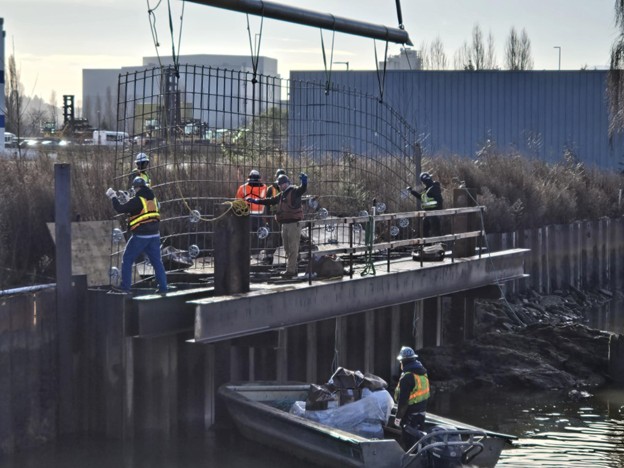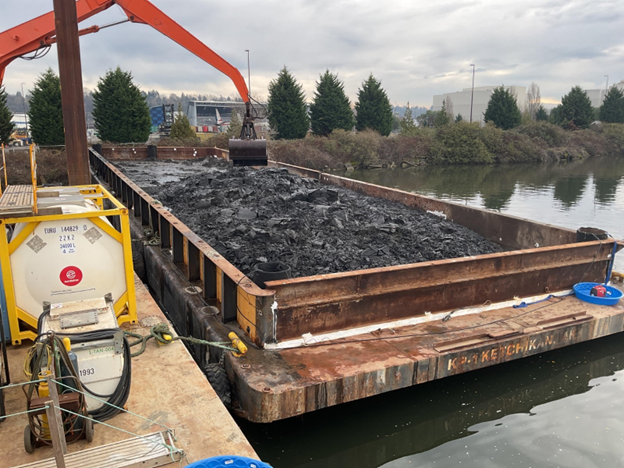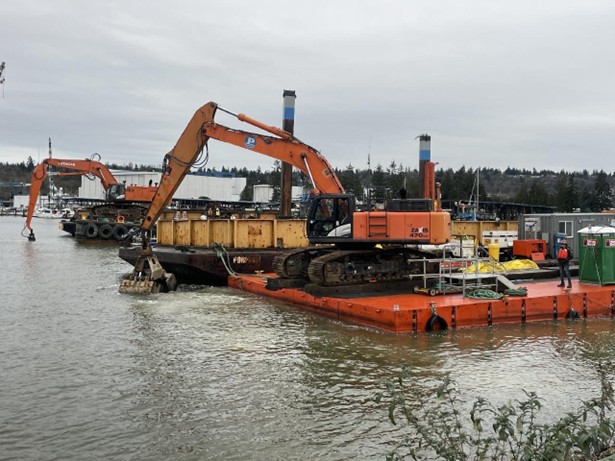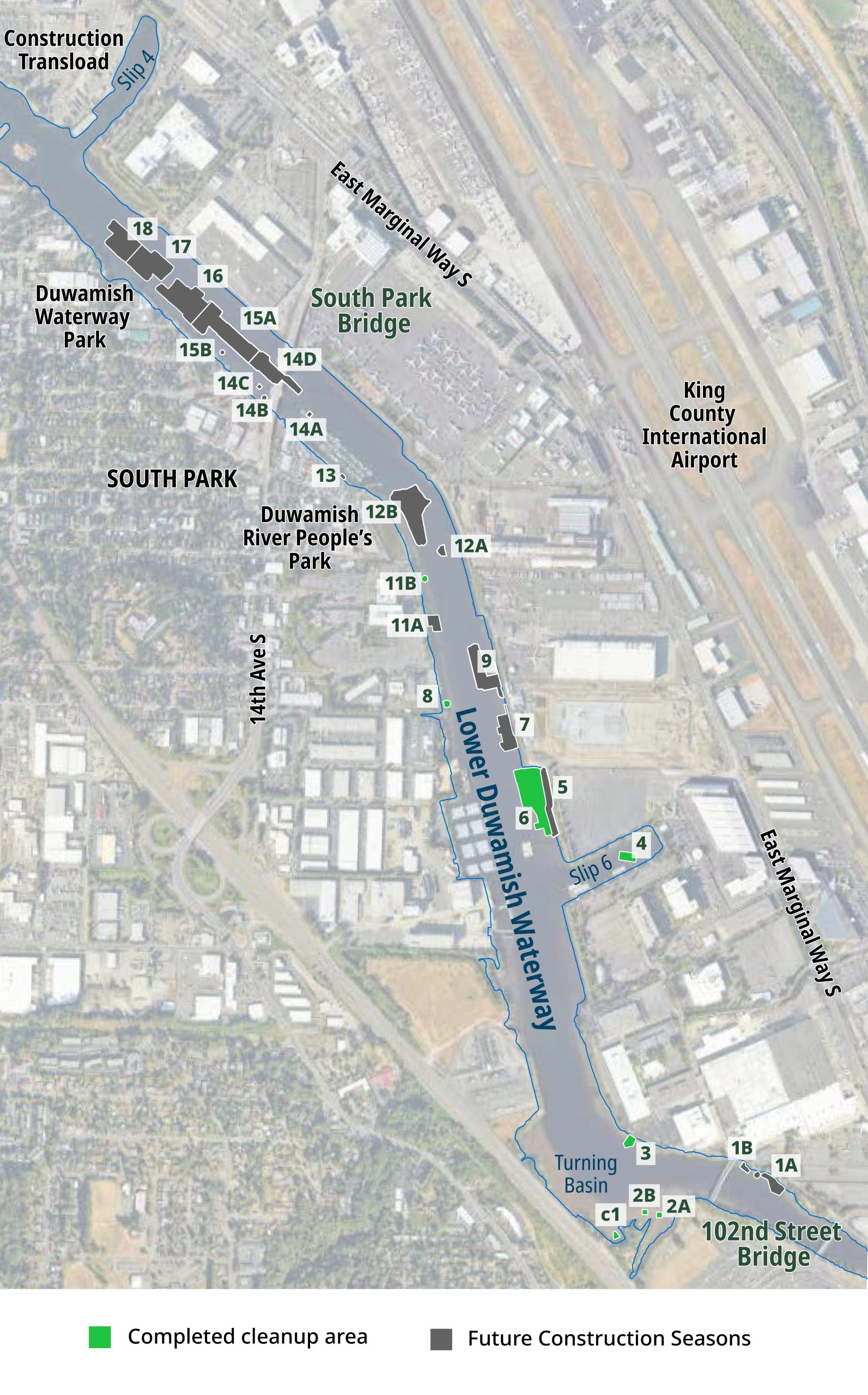This page may be viewed in: English Español ភាសាខ្មែរ Tiếng Việt
The first season of cleanup construction for the upper reach is complete! Construction will resume in October 2025.
What’s happening now:
March 2025
- All construction is done in Sediment Management Areas (SMAs) 2A, 2B, 3, 4, 6, 8, 11B and C1. In SMA 9, installation of sheet pile to stabilize the shore was completed in anticipation of dredging adjacent sediments. Please see the map of cleanup areas linked below.
- This concludes construction activities for the first construction season in the upper reach of the Lower Duwamish Waterway. We are now focused on demobilizing construction equipment.
- Season 1 in-water cleanup activities ended on February 27, and the last above water work was completed on March 5. Demobilization of the construction equipment will occur during the week of March 10. Demobilization will include removing equipment and supplies from the barges. Demobilization activities will take place at the Contractor’s (Pacific Pile and Marine) waterfront property along South Riverside Drive.
- During this first season, construction teams removed approximately 14,000 cubic yards of contaminated sediment, filling 222 rail cars. This is about 18% of the upper reach cleanup area.
- You can reach out to our team during construction hours should you have questions or concerns. Reach out to us at info@ldwg.org or 1-888-561-LDWG (1-888-561-5394).
Environmental and Community Reporting:
Stay Connected:
Read past updates
March 7, 2025 Newsletter
February 28, 2025 Newsletter
February 21, 2025 Newsletter
February 14, 2025 Newsletter
February 7, 2025 Newsletter
January 31, 2025 Newsletter
January 24, 2025 Newsletter
January 17, 2025 Newsletter
January 10, 2025 Newsletter
January 3, 2025 Newsletter
December 27, 2024 Newsletter
December 20, 2024 Newsletter
December 13, 2024 Newsletter
December 6, 2024 Newsletter
November 21, 2024 Newsletter
What to Expect During Construction
Construction will take place in specific areas within the waterway’s upper reach, which extends from the South 102nd Street bridge downstream to the Duwamish Waterway Park.
In general, the public can expect to see:
- Construction equipment working on the river, including tugboats, excavators on barges, and barges carrying material to and from work areas.
- The Contractor will use barges to move dredged sediment from cleanup areas to the Duwamish Reload Facility (operated by Waste Management) located at 7400 8th Avenue South to transfer sediment from barge to railcars. The material will then be transported to a regulated landfill.
- People in smaller boats observing, doing surveys, monitoring water quality, and collecting samples.
- People working mostly weekdays between 7 a.m. and 7 p.m. and, only if necessary due to tides and other factors, work before or after 7 p.m. Movement of barges may occur outside of these work hours. Saturday work is also allowed. Night work will be limited. The project team will provide advance notice to nearby residents, including marina residents, and businesses.
- Lights for safe work during dark hours and noise related to construction equipment.
Construction photos




About the Construction
King County, as a member of LDWG, hired Pacific Pile and Marine as the lead contractor to carry out cleanup construction in the upper reach.
Construction in the upper reach will take place during the construction season over the next three years, ending in February 2027. The construction season is typically October through February each year. In-water construction activities are restricted to these months to protect certain fish species.
After the Lower Duwamish upper reach cleanup is complete, construction will continue downstream toward the south end of Harbor Island over the next decade. You can read more about the pollutants we will clean up from the river here.
Learn more about the Lower Duwamish Waterway Superfund Site cleanup on the EPA website.
Planned Construction Activities
You can expect the following construction activities:
- Staging of equipment and materials: Setting up, organizing, and storing materials before use in construction.
- Offloading: Transferring materials like dredged sediment from one mode of transportation to another, such as from a barge to a truck or train.
- Transporting materials: Transporting dredged materials and debris from one location to another, including by barge, rail, or truck.
- Disposing of contaminated materials: Disposing of contaminated materials at a permitted commercial landfill.
- Surveying and inspections: Documenting the condition of the work sites and surrounding areas, as well as the progress of construction before, during, and after construction (including taking photographs).
- Removing piling and debris: Temporarily removing the piling that supports Tribal fishing, removing piles no longer in use, and removing any debris from dredged areas.
- Installing replacement piling and reinforcing structures: Replacing any Tribal fishing piling that are temporarily removed for construction access. Reinforcing any shoreline bulkheads to allow dredging next to the bulkhead.
- River sampling: Collecting water samples to confirm that dredging is being conducted as required, to comply with water quality standards.
- River sediment sampling: Collecting sediment samples to confirm dredging has removed the contaminated sediment as required.
- Site cleanup and demobilization: Removing construction equipment and materials from the work site.
Communications and construction timeline for the Upper Reach
| 2024 | 2025 | 2026 | 2027 | ||||||||||||||||||||||||||||||||||||||||||||
| Q1 | Q2 | Q3 | Q4 | Q1 | Q2 | Q3 | Q4 | Q1 | Q2 | Q3 | Q4 | Q1 | Q2 | Q3 | Q4 | ||||||||||||||||||||||||||||||||
| Contractor hired | |||||||||||||||||||||||||||||||||||||||||||||||
| Contracting and Bid | |||||||||||||||||||||||||||||||||||||||||||||||
| Construction Submittals | |||||||||||||||||||||||||||||||||||||||||||||||
| Pre-construction Outreach | |||||||||||||||||||||||||||||||||||||||||||||||
| Construction Season 1 | Construction Season 2 | Construction Season 3 | |||||||||||||||||||||||||||||||||||||||||||||
| Ongoing Community Outreach and Communications | |||||||||||||||||||||||||||||||||||||||||||||||
How EPA, LDWG, and the contractor will work to reduce the impact of cleanup construction on the community.
LDWG and the construction contractor, with the oversight of the EPA, will work to learn about and mitigate community concerns as practical through digital and in-person outreach such as responding to project emails and the project phone line, and by speaking with people at community events.
We are dedicated to limiting the impacts of construction on those who work, live, play, and gather in the area.
We welcome the community to contact the Cleanup Outreach Team with any concerns related to the cleanup. You may reach us via email at info@ldwg.org or by phone at 1-888-561-LDWG.
Resources
- Green Remediation factsheet (Fall 2024)
- Environmental and Community Protection factsheet (Fall 2024)
- Short video, Start of Construction (December 2024)
- Joint News Release, Start of Construction (December 2024)
- Community Outreach and Communications Plan (January 2024)
- Community Impacts Mitigation Plan (September 2024)
- Community Outreach and Communications Plan with Community Impacts Mitigation Plan Summary (July 2024) Khmer | Vietnamese | Spanish
- Sediment Cleanup Construction Handout (September 2024) Khmer | Vietnamese | Spanish

